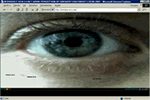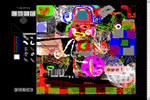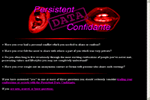|
|

A selection of participative art on-line by Roberta Bosco
and Stefano Caldana
Internet was born to be a powerful tool of information
exchange and simultaneous collaboration among people from
different places in the world. Throughout its development
those who have lost sight of this fundamental fact have
failed or are destined to do so. This is not the case of
digital artists who, from the beginnings of this new artistic
expression, have focused their efforts and creativity on
a participative, collaborative and interactive direction.
Digital Jam is a selection of 11 projects
conceived for the Internet that shows different tendencies
of artistic investigation, focused on the collaborative
aspect of the creative process on-line in the course
of the last 7 years.
The participative experience in digital art has very deep
roots going back to Nam June Paik’s
experiences at the beginning of the 70’s. However,
regarding net.art, one of the first was American artist
Douglas Davies with The World’s First
Collaborative Sentence, a multimedia document whose development
and expansion depend on the audience who, since 1994, adds
text, sound, images and video. That year, the artistic community
sensitive to innovative projects discovered to have a means
at their disposal, which shortened distances and changed
completely the concept of work of art and copyright and,
of course, began to use it.
We are not in favour of encyclopaedic selections, so we’d
rather risk choosing a series of projects which, in our
opinion, shows the numerous tendencies in the field of artistic
collaboration on-line. Within the historic ones, we have
chosen Davies and Paul Vanouse and their
database of secrets and excluded undoubtedly interesting
works, such as The Most Wanted Painting by Komar
& Melamid and Please Change Belief by Jenny
Holzer. French artist Gregory Chatonsky
and Americans Marek Walczak and Martin
Wattenberg take sides in the discussion of digital
art collections, and Eric Zimmerman explores
the dynamics of the interpersonal relations on-line with
an addictive and evil game. Andy Deck allows to perform
a graphic jam session in real time, Hannes Niepold
suggests a collaborative net.comic in constant growth and
Bernd Holzhausen keeps on expanding his
famous Icontown, a city made of pixel buildings by thousands
of icon-addicts. Thomax Kaulmann presents
its already historic Open Radio Archive Network Group and
John Klima challenges the usual model of
interactivity and collaboration on the Internet with Glasbead.
Finally, No/E.html, a webring by Mexican artist Arcangel
Costantini, links with mythical works such as Desktop
IS or Refresh by Russian artist Alexey Shulgin,
webrings of artists pages from all over the world, which
we have excluded because they have lost several intermediate
rings and they are immediately interrupted.
Digital Jam invites the observer/user to leave his/her
passive role in order to take part in first person in this
creative jam session on the Internet.
PROJECTS: |
 |
1. Gregory Chatonsky (Francia)
IO-N.NET
http://io-n.net/
A site, a desinence, an artists' community in progress
which shares a domain with Chatonsky
where you can contribute all your digital designs. Brief
projects, extracts of more complex
thoughts, snapshots of a physical and mental state and reflections
in Flash format, gathered from
a common platform: ION, such as position, collaboration,
repulsion and a long list of names as
suggesting as the projects they give way to. The last work
... mondialisation, naturally! |
 |
2. Arcangel Costantini (México)
No/E.html
http://www.unosunosyunosceros.com/No/E.html
As the historic webrings of the first period of net.art, No/E
is also a ring which shares a splash
page where, as the title in Spanish points out, you are not
allowed to stop. Many Spanish sites
devoted to digital art take part into this project, which
also examines the traffic signs' meanings
and analogies on the Internet, such as the pioneer Aleph or
the most recent Fiftyfifty. |
 |
3. Douglas Davies (USA)
The World’s first Collaborative Sentence
http://ca80.lehman.cuny.edu/davis/
In this project Davis thinks about those changes the interactivity
of digital media imply for artists.
It is a multimedia document whose development and expansion
depend on the audience who
- since 1994 - adds text, sound, images and video. The project,
which currently belongs to the
Whitney Museum in New York, included at the end of the year
2000 more than 200.000
contributions in a dozen of languages. |
 |
4. Andy Deck (USA)
Open Studio
http://draw.artcontext.net
Andy Deck opens his studio in New York for everyone who wants
to take part in a graphic jam
session. He has created a common interface for this where
several users can work in real time
in the same picture. This project, based on software written
in 1990, is part of the open source
movement, that is, open code, co-operative and free. |
 |
5. Bernd Holzhausen (Alemania)
Icontown
http://www.icontown.de
A work in progress which proves that a project on the Internet
may have a continuous evolution
during several years... in this case, four! In this city made
of pixel buildings carried out by
thousands of netizens, there are skyscrapers and houses, igloos
and shacks, churches of
several denominations and public buildings, and each one has
the owner's name and his/her
webpage. Everyone can freely use this icons bank although,
being a "donation ware" project,
you are invited to donate an amount of money or time to an
organization helping homeless.
Icontown is a virtual city in constant evolution. Participative,
multiracial, multicultural and also
supportive. |
 |
6. Thomax Kaulmann (Alemania)
ORANG - "Open Radio Archive Network Group"
http://orang.orang.org/
In 1998 Thomax Kaulmann conceived this project addressed to
musicians, DJs, artists, record
companies and independent labels, in order to become a dynamic
platform for the distribution of
sound. ORANG represents a new radio generation which is being
developed on the Internet. Every
netizen can access the database and hear sound files, divided
in musical genres. However, you
need a password, delivered after being registered as a user,
to be able to add your own
compositions to the project. |
 |
7. John Klima (USA)
Glasbead
http://www.glasbead.com/
A project belonging to the so-called Software Art trend carried
out by a famous Microsoft
programmer in the computer scene of Seattle, who left a brilliant
and profitable career to devote
himself to art. In the bohemian Lower East Side in Manhattan,
Klima has developed a program
that allows to create in real time an enormous variety of
visual and sound scenes in a three-
dimensional environment, where as many as twenty people connected
via Internet may interact.
In 2000 Glasbead won an award at Siggraph to the most interesting
contribution in the field of
interactive art. |
 |
8. Hannes Niepold, Hans Wastlhuber (Alemania)
Cointel
http://www.cointel.de
A non-lineal net comic in constant growth, whose name is made
up of 'co' for comic, cosmic and
co-operative and 'intel' for intelligence. The last vignette
of the different stories which are being
developed is always empty. Users are invited to fill it before
being added to the story, where it
will remain with the last contributions, so that netizens
can vote for the one which will become
permanently part of the project. The works ruled out are not
deleted, but they are changed into
alternative narrative paths which channel the story into other
courses, creating a democratic
narrative structure which evolves branching out in different
directions. |
 |
9. Paul Vanouse (USA)
Persistent Data Confidante
http://www.textgenomics.com/
This project, exploiting the guarantee of anonymity on the
Internet, suggests a secrets' transaction:
users must leave one secret to be able to read another, which
can be scored. In this way, those
secrets with the lowest score, that is the less interesting,
are deleted from the list and guests,
having a influence on the web content, become co-curators
of this secrets' database. A project
which may be considered an example of pure net.art due to
its simplicity and real interactivity. |
 |
10. Marek Walczak, Martin Wattenberg (USA)
WonderWalker
http://wonderwalker.walkerart.org/
This project introduces the concept of "WunderKammer"
in the digital age, the wonders room of
the 17th-century aristocratic houses. Whereas these were private
collections of weird and precious
objects, Wonderwalker has been conceived as a website collection-archive,
where everybody can
take part. It is an endless project that has much more in
common with interaction than with a
classification interest in itself. It is something similar
to a social space where collecting is used as
a way of communication. The collection may be displayed in
three maps: icons, collectors and
timeline. |
 |
11. Eric Zimmerman (USA)
SiSSYFiGHT 2000
http://www.sissyfight.com
A project staging the fight between three bunches of schoolgirls,
with a look which reminds a
little bit to the comicbook artist Robert Crumb. In order
to win you have to become the most
popular girl of the playground, ruining your opponents'
image and self esteem. This game, which
is always very crowded, shows the dynamics governing personal,
social and professional relations
in Western society. As in real life, established relations
are essential so, if you want to win the
game, make sure to chat with the right people and reconcile
strategies with them. |
| Text originally published in ArtFutura's 2001
catalog. |
|
|